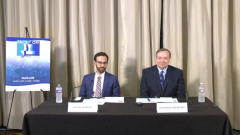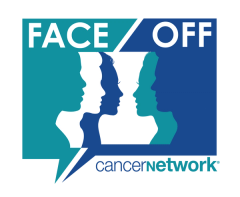
Cross Q&A: Ponatinib Dosing in Relapsed/Refractory Chronic-Phase CML
Expert perspectives from the Mayo Clinic and UT Southwestern teams on applications of the OPTIC study and optimal ponatinib dosing in chronic myeloid leukemia.
Episodes in this series

Transcript:
Judy Schreiber, PhD, RN: Since our presentations on CML [chronic myeloid leukemia] are going to be by the male doctors, comments [or questions] can come from either side. First to Texas, if you have any.
Adeel Khan, MD, MPH, MS: I can start off. As a myeloma doctor, I’ll keep my questions on CML quite simple. You mentioned the unfortunate issues that, that ponatinib had with [the] PACE [NCT01207440] and EPIC [NCT01650805; trials], and that’s what inspired this study here with the tolerance of the TKI [tyrosine kinase inhibitor], but with asciminib in the mix now with great data supporting it, how would you fit that vs ponatinib in practical practice?
Kebede Begna, MD: Really it is [a] very interesting [and] important question. I am much older than you, I believe when I was a resident in New York, Celebrex was everywhere. So everywhere was ordering Celebrex, and after 5years, all of us are burned out… .See [in]…the comparison study between asciminib and bosutinib there are some vascular events, so my preference is to use the patient phenotypic characteristic, not just decide then.My preference in comparison to asciminib is ponatinib.
Larry Anderson Jr, MD, PhD, FACP: It looked like it was pretty clear if they had mutations that the higher dose was required for the good response. If they did not have the inactivating mutation or the mutations were you able to get by with the lower dose and some of those patients?
Kebede Begna, MD: No. The reason is we use Sanger sequencing to find out mutations. The absence of mutation is not an indication that they don’t have, because the level of cutoff is 5%. If they have a mutation about 3% and 4%, you might miss them. Even if you…see the data, those without T315 mutation have a higher effectiveness when you use a higher dose. The key is when to decrease the dose to avoid the toxicity, one you have to be very selective in choosing your patients. In older individuals who have coronary disease, [are] smokers, [have] diabetes, and so on you may start but if you use a goal is really to achieve a significant reduction start higher and go lower is based on the evidence we have.
Abhishek Mangaonkar, MBBS: Building on that, I think the big thing is really the vascular [adverse]effects that worry me with ponatinib. I would probably discuss this in a bit in the next presentation, but it’s very important to assess the patient in terms of cardiovascular risk factors. I think that you can try to control what you can before you start them. I’ve always wondered whether you could start at a lower dose and then sort of see how they do and then go higher, but I don’t think we have adequate data for that induction aspect where you could start with a 15- to 30-mgdose and then go higher. With this data, it’s pretty clear that you can come down on the dose on a lot of these patients, as long as the BCR level is less than 1%, as soon as that milestone is achieved.
Kebede Begna, MD: As Abhishek said, I tried it but I burned it out. I tried with the lower dose and because you give more time for those unstable leukemias in the bone marrow to evolve and change their mutation. I don’t think it is advisable to start low and go high.
Transcript edited for clarity.
Newsletter
Stay up to date on recent advances in the multidisciplinary approach to cancer.





















































































